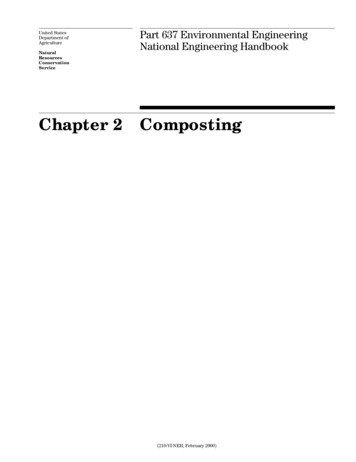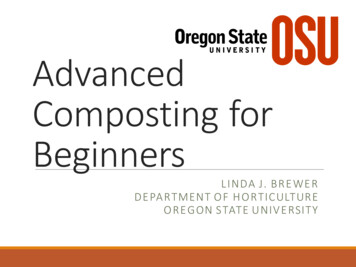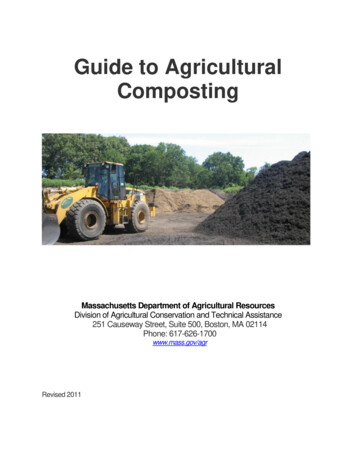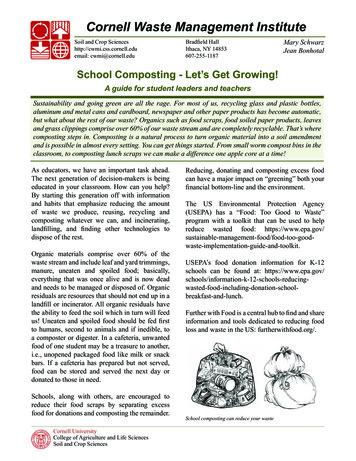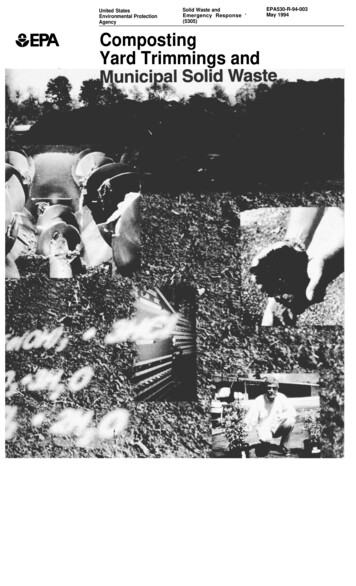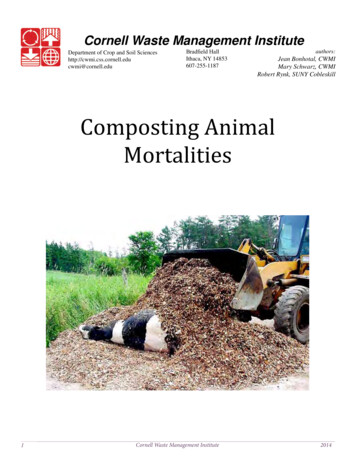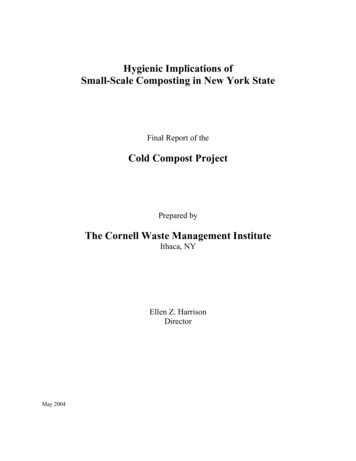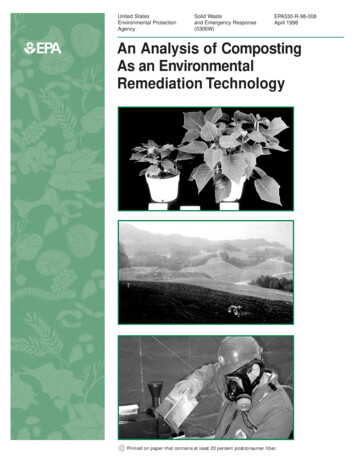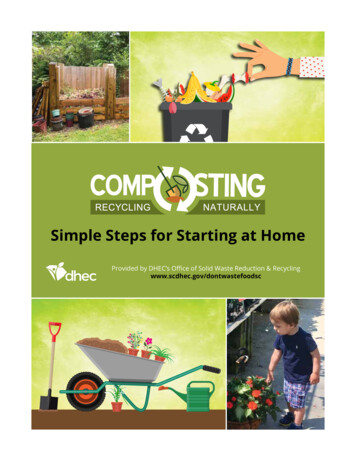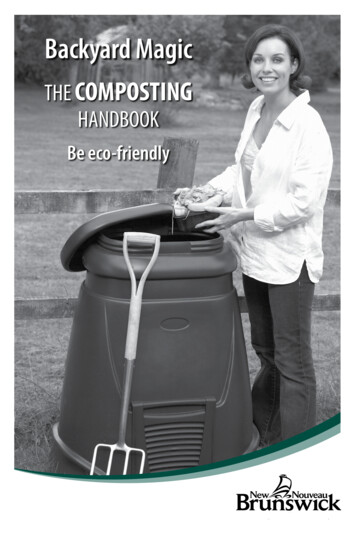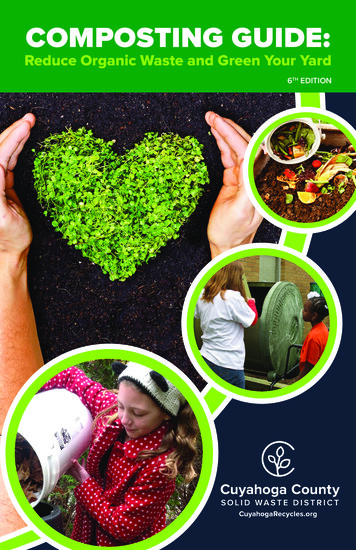
Transcription
COMPOSTING GUIDE:Reduce Organic Waste and Green Your Yard6TH EDITION
COMPOSTABLE OF CONTENTSWhy Compost, Supplies Needed . . . . . . . . . . . . . . . . . . 1Compost Bins . . . . . . . . . . . . . . . . . . . . . . . . . . . . . . . . . . 2Buy, Build . . . . . . . . . . . . . . . . . . . . . . . . . . . . . . . . . . . . . . 2Size, Placement . . . . . . . . . . . . . . . . . . . . . . . . . . . . . . . . 2Start A Compost Pile . . . . . . . . . . . . . . . . . . . . . . . . . . . . 3Maintaining a Compost Pile . . . . . . . . . . . . . . . . . . . . . . 4How to Produce Optimal Compost Conditions . . . . . . 4Problem Solving . . . . . . . . . . . . . . . . . . . . . . . . . . . . . . . . 5Compost Dos and Don’ts . . . . . . . . . . . . . . . . . . . . . . . . 5Using Finished Compost . . . . . . . . . . . . . . . . . . . . . . . . . 6Other Composting Methods . . . . . . . . . . . . . . . . . . . . . . 7Compost Resources . . . . . . . . . . . . . . . . . . . . . . . . . . . . 8If you already compost in your backyard, pleaseadd yourself to the compost survey list by emailingswdinfo@cuyahogacounty.us. Answering the annualsurvey will give a recycling credit to your city.
COMPOST IS A dark, crumbly soil amendment. A waste reduction strategy for yard andfood waste. Nature’s way of recycling. Natural mulch. Nutrient rich. A simple way to prevent methane gasproduction.WHY COMPOSTComposting is a great way to keep organic materialout of landfills. It is a good environmental practice,and an inexpensive way of adding nutrients backinto the soil. Applying compost to soil improves itstexture, structure, aeration ability and water holdingcapacity. It adds-up to improved soil fertility androot development. Trees, flowers, and vegetableswill grow healthier with less chemicals or fertilizers.SUPPLIES NEEDED Compost bin or outdoor area to compost. Shovel. Aeration tool such as a pitch fork or compostaerator. Kitchen food scrap holding pail. Thermometer. Organic material such as yard waste, food scrapsand shredded paper. A compost activator or accelerator includingurea, manure, or bone meal to help the compostprocess start quickly and efficiently.Composting Guide 1
COMPOST BINSBuyThe Cuyahoga County Solid Waste Districtsells affordable bins during its “CompostSeminars and Bin Sales.” Log ontoCuyahogaRecycles.org to find out seminardates and locations. The Wishing WellComposter, Ultimate Dirt Machine Digesterand Sure-Close pail will be sold duringthese events. If you can’t wait for the nextscheduled event, then you can buy a bindirectly from the District. Facility hours areMonday through Friday from 8:30 a.m. to4:30 p.m. Check or cash only and all salesare final.Many garden, hardware stores andwarehouse clubs carry compost binsseasonally. You can also find them onlineat www.planetnatural.com and www.cleanairgardening.com. Brand names includeEarth Machine, Tumbleweed, EnviroCycle,Sun-Mar, ComposTumbler, Earth Engine,Prestro Hoop and Garden Gourmet.We recommend bins that sit on the ground,but consider a rolling compost bin for moreflexibility in placement, such as close to thehouse or in the garage. These bins are moreexpensive, but easily add oxygen to the pile.Also, small scale composting can be doneindoors by either buying a kitchen composteror making one out of a plastic container.Pile SizeAn effective compost pile must be largeenough to hold the heat in the center whilestill allowing air to permeate the pile. Whencreating a pile, maintain the size between3’ x 3’ x 3’ to no larger than 5’ x 5 x 5’.Adding the same volume of materials to apurchased bin will optimize decomposition.Placement Look for a level, well-drained area. Keep it accessible. Keep the pile or bin in a sunny spot to trapsolar heat. The compost may need waterin the summer. Shelter it near a building or landscapingthat blocks wind to protect the compostpile from freezing winds. Build a pile over permeable soil or lawn. Look for a spot that allows you tocompost discretely, especially if you haveneighboring yards close by.UltimateDirt MachineIf you are a member of garden club or otherorganization, please consider hosting aComposting Seminar and Bin Sale. Call fordetails at 216-443-3749.BuildBuild-your-own compost piles can becontained in chicken wire, bricks or woodpallets. Follow the proper pile size whenbuilding. The least expensive method is justcreating a pile. Please note some cities mayrequire an enclosed pile and have other ruleson compost piles and their contents.2 Composting GuideWishing Well
START A COMPOST PILE1. Place several inches of base material such aschopped brush, twigs or wood chips on the ground.This will allow air circulation around the base of pile.(Skip this step if using a compost mixing container).2. Alternate green organic material containingnitrogen and brown organic material containingcarbon as you build the pile. Keep a ratio of 1-partgreen and 2 to 3 parts brown. Do not compact layersto allow for air circulation.3. Add several full shovels of an activator (agedcompost or garden soil) as the pile is being built tointroduce microorganisms. Activators such as manure,bone meal or urea fertilizer will provide nitrogen toencourage the reproduction of microorganisms.4. Stir pile.5. Water the pile, so it’s moist, but not wet.Pile Composition30% green or nitrogencontaining organic matterVegetables, fruits, flowers, plantclippings, grass clippings, coffeegrinds, manure, etc.ESSENTIAL ELEMENTSOF A COMPOST PILEORGANICMATERIALOXYGENMIXCOMPOST CREATURES MICROORGANISMSWATER70% brown or carbon basedorganic matterDead leaves, straw, sawdust,wood chips, shreddednewspaper, corn stalks, cottonrags, nut shells, pine needles,etc.The correct mixture affectsquality of the compost and thespeed of decomposition. Anothermethod is comparing C:Nratios of organic material. Theoptimal ratio is 30:1. Ratios ofcommon organic material can beresearched online.Composting Guide 3
MAINTAINING A COMPOST PILEThe instructions below will help you create compost within six months. Composting is like ascience experiment; it needs to be observed and adjustments made.Compost creatures Micro-organisms like bacteria,actinomycetes and fungi. Macro-organisms of insects and arthropods likeworms, centipedes, sow bugs, beetles, snails or slugs.An initial source of compost creatures can be addedthrough garden soil or aged compost. Also, the pile should be maintained to provide themappropriate food, water and oxygen. The creatures will help decompose the organics faster.MoistureThe compost should have 50% moisture content and feel damp like a wrung-out sponge.Water can be added to the compost pile by either adding green material or sprinkling thepile with water. Left over non-dairy beverages can be added to wet the pile.OxygenThe pile should be aerated about once a week by: turning the pile outside to inside or top to bottom stirring the pile using an air stack or aerator tool to bring air into the center of the pile rotating a tumbler compost bin every two to three days.Surface AreaIncrease the surface area by shredding or cutting organic material into smaller pieces.Proper sizeKeep the volume around 3 feet cubed.Proper TemperatureMost backyard compost piles only reach 90 – 120 . If you do not keep a consistentaeration schedule, then turn the pile when the temperature peaks. If the pile no longerheats up, it may be an indication that the compost is ready for application.Hint: If you’re consistentlyadding kitchen scraps toyour compost pile, thenkeep a source of carbonnext to your compost binto maintain the properratio.4 Composting Guide
PROBLEM SOLVING To help dry an over watered pile, add sawdust, straw or wood chips or place wood planksunderneath the pile to ensure good drainage. When the pile is too dry, turn it over, and add greens and water. If the pile is damp, sweet smelling and will not heat up, it needs nitrogen. Turn the pileand add grass clippings, coffee grounds, manure, blood meal or urea fertilizer. When the pile smells like ammonia, add brown leaves, sawdust, straw or wood chips. If the materials do not seem to be decomposing, then add nitrogen, turn the pile andmaintain 50% moisture content. When unwanted creatures are interested in compost, bury the food waste close to thepile’s center and avoid “compost don’ts.”For more information on problem solving, see the compost resources on page 8.Compost DosLeavesGrass clippingsPlantsNut shellsStraw and hayFruits, vegetables andgrainsEgg shellsCoffee grounds or tealeavesCompost Don’tsMeatsFishDairy productsOil or fatty foodsBonesCat and dog droppingsSawdust and wood chipsCat litterDryer lint - natural fibersonlyDiseased or insectridden plantsShredded paper andnewspaperNoxious or invasiveweedsDead flowersAshes from coal orcharcoalCertain manuresBranches or limbsYard trimmings treatedwith chemical pesticidesComposting Guide 5
USING FINISHED COMPOSTThe composting process will take six months orlonger in the Northeast Ohio climate before thecompost is ready for use. Compost is ready whenit has decomposed into small, crumbly, dark brownsoil-like particles. Remove the fresher yard debrisfrom the top of the pile and start a new pile. Usecompost: as a potting mix, add soil and sand as a starter for plant seedlings as a seed starter, add top soil or sterilized pottingmix to prevent burning the seeds to encourage healthy growth of trees by diggingin a layer of compost around the trees’ drip line as mulch around plants as fertilizer on grass, indoor plants, landscaping,around trees and in the garden as a top dressing for the lawn: add 3 parts sandand loam to 1 part compost6 Composting Guide
OTHER COMPOSTING METHODSVermicompostingThis composting uses red wiggler worms to decompose foodscraps.Passive CompostingIt is similar to active composting, but it needs up to two yearsto finish decomposing because the pile is not managed.Basically, deposit organic yard waste in an open pile, binor a wire cage and let nature take its course. For betterresults, follow instructions to start a compost pile. Skip themaintenance section.Trench or Pit CompostingDig up to a 12” trench or 18” hole and deposit food and yardwaste. Cover with several inches of soil. Let nature do thework. Trench composting is good for next season’s gardenrows. Plant a tree, shrub or other plant over the pit.GrasscyclingLeave grass clippings on the lawn to return the nutrients to thesoil. Use a mulching mower or cut dry grass more frequentlywith sharp blades to encourage grass to decompose quickly.If large grass clumps are left on the lawn after mowing, allowthem to dry and mow lawn again to disperse piles evenly.Composting ToiletSome people may find a composting toilet a goodenvironmental idea, especially for cabins or remote areas. Itdecomposes human waste into usable compost. The finishedproduct should only be applied around trees and landscaping.It prevents the loss of nutrients and decreases waste goinginto an already taxed sewer or septic system. Also, acomposting toilet can be placed in an area where plumbing isa challenge.Pet Waste ComposterYou may need to check into city regulations with this one. It’sbeen a suggested method in cities that do not allow dog wastein the garbage. A pet waste composter works like a smallseptic system. It involves digging a hole, cutting out a plasticbin and adding a septic starter (enzyme-active biologicalcompound formulated to increase the digestion rate ofsewage) and dog waste.DigesterThis bin allows for all yard and food waste, and it can beused for some pet waste. It follows the passive methodof composting and only produces a small amount of soilamendment. A septic starter could be added to speed updecomposition.Composting Guide 7
See our website for a schedule of Compost Seminars and Bin Salesand sign up through the survey monkey link. Call us to find out how tohold a seminar during an organization meeting or lunch and learn inyour work place.Compost ResourcesUS Composting Council http://compostingcouncil.orgCompost Guide www.compostguide.com or http://www.ranchomondo.com/compost.htmDog Waste Composting System http://cityfarmer.org/petwaste.htmlHow To Compost www.howtocompost.org or posting Toilet -reviews/Composting Video Turning Your Spoils into Soil www.ct.gov/dep/cwp/view.asp?a 2718&q 399598&depNav GID 1645Grasscycling www.turffiles.ncsu.edu, type grasscycling in keywords and click on pub and factsheet tabMaster Composter - www.mastercomposter.com/For KidsComposting Coloring Book Compost for Schools res of Herman the Worm www.urbanext.uiuc.edu/worms/Early Educator Compost Worksheets https://cuyahogarecycles.org/early education worksheets8 Composting Guide
Sure-Closefood scrap holding pail1.9 gallons; 11” x 9.5”; dishwasher safe; ventsfor air flow; lid stands for secure closure; gripsfor easy handling; odor and blemish resistant;HDPE plastic. 5Yard ButlerCompost aerator; all-steel construction; antirust coating; lifetime guarantee for materialand manufacturing defects; mixes compostwithout heavy lifting. 20Compost ThermometerEasy-read dial; stainless steel body; stainlesssteel 19” probe. 10Compost TeaAdd nutrients to plants to help them grow by makinga compost tea from finished compost.Add water to the pail and let it sit for 24 hours if frommunicipal system.Put a small shovel of compost into the bucket and letsoak for 12 to 24 hours;Apply immediately to plants, lawn and garden toinfuse them with good microbes and nutrients.
4750 East 131 StreetGarfield Heights, OH 44105216-443-3749www.CuyahogaRecycles.orgWhen you’re done with this brochure, pass it on, recycle it orshred it into the compost pile.Printed on paper that containspost-consumer recycled contentE
Composting is a great way to keep organic material out of landfills . It is a good environmental practice, and an inexpensive way of adding nutrients back into the soil . Applying compost to soil improves its texture, structure, aeration ability and water holding capacity . It adds-up to improved soil fertility and

